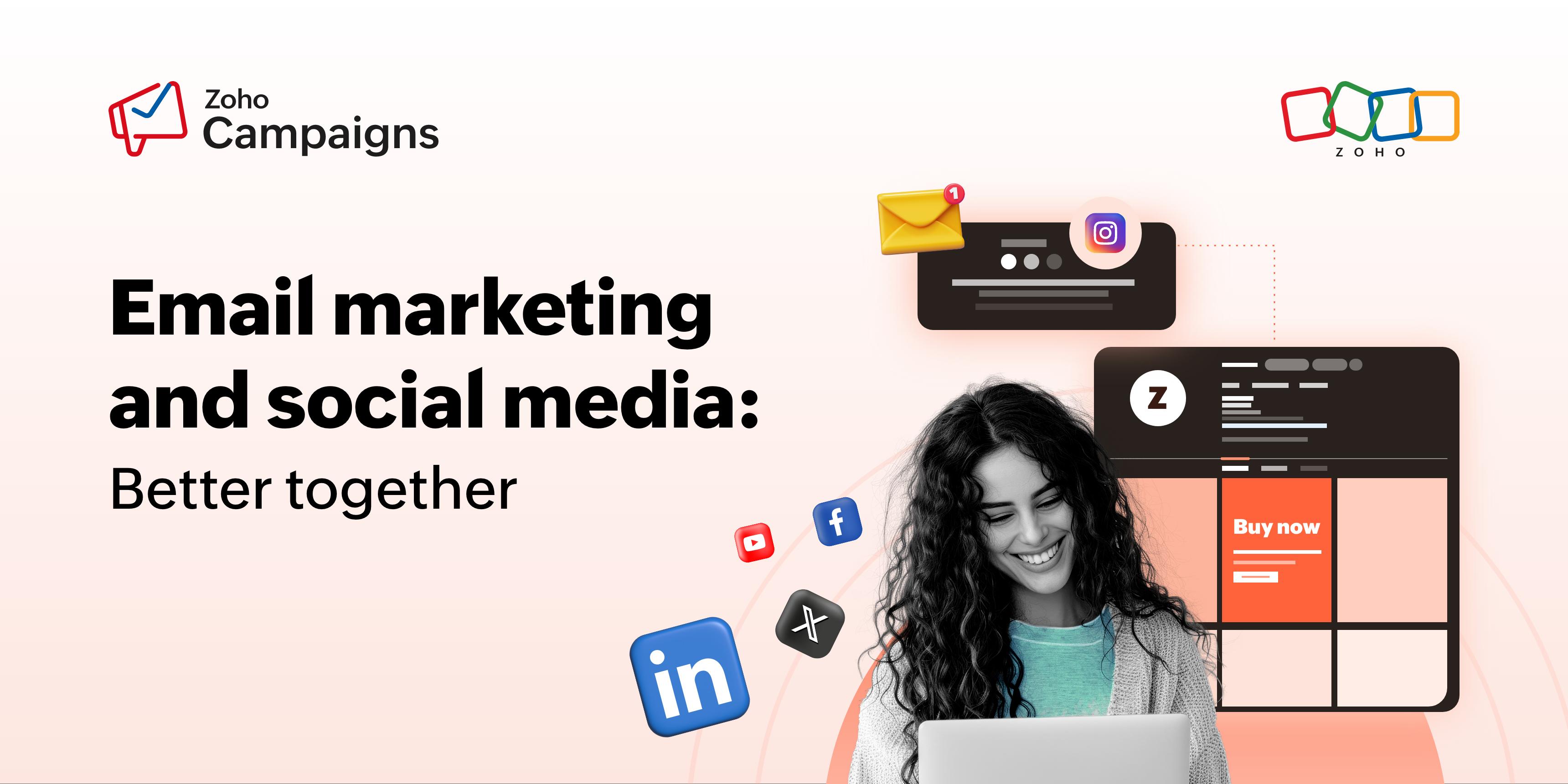- HOME
- Email Marketing
- How to build an email list through social media—with practical examples
How to build an email list through social media—with practical examples
- Last Updated : March 25, 2024
- 963 Views
- 6 Min Read

You have a decent-sized email contact base consisting of people who have opted in to receive emails from you. You create great campaigns with well-crafted emails—yet not many are reading them.
Does it seem like most contacts from your email list have fallen off the face of earth? This is called email list decay.
In this blog, we'll go over why you should build your email list, how email lists degrade over time, and how you can build them back up with the help of social media.
Why build an email list?
Many companies build email lists even before they finish building their actual products. That's because it takes a long time to build a quality email list, and once you have an audience looking forward to hearing from you, it makes marketing much easier.
While there are countless social channels you can use to reach your audience, email is the one channel you own. You aren't dependent on an external platform and its ever-changing algorithm; you can continue engaging with your audience on your own.
In many ways, posting on social media is like spraying and praying. But emails aren't like that. You can tailor your messaging to different segments of your audience and send highly personalized communications that will appeal to the reader.
So if you've gotten your email basics right, why not try and reach as many potential customers as possible? Building an email list helps you scale up your email marketing efforts.
But email lists don't stay the same. The contacts in your email lists degrade over time and may have to be removed, and you'll need to keep adding more contacts to keep up the quality of your email list.
Why do email lists decay?
Email lists degrade over time for a variety of reasons.
Change of address
People leave jobs all the time. This will lead to email addresses getting deleted and thus, a natural reduction in delivery rates. In some cases, the email inbox might still be active but not be actively monitored, bringing down your open and click rates.
In other cases, the contact might simply have used a temporary email address to receive some information from you and might have completely abandoned that address.
Change of role
In most organizations, people tend to shift roles or departments. So while they're still with the company, your emails might no longer be relevant because of their changed roles.
Change of context
To put it bluntly, your content is no longer interesting or relevant for your audience. Maybe you've not kept up with the industry trends, or maybe there are others presenting better information in a more attractive format.
Spam trap
Your emails end up in the spam folder in one of two ways: a particular contact has marked you spam, or (and this is much worse) the email provider has marked you spam, and your emails don't reach most of your contacts.
Your emails get flagged as spam for multiple reasons, such as sending too many emails too often, having open rates that are too low, not complying with email regulations, and so on.
Things happen
You might be doing everything right—purging your email list of inactive accounts, adhering to regulations, keeping up with industry and email trends. Even so, your email list might degrade through no fault of your own.
Sometimes contacts are genuinely overwhelmed with the number of emails they're receiving and are unable to catch up (I should know; I've been unable to catch up with most of my favorite newsletters for ages).
When you find your email list degrading for whatever reason, it's important to take the time to add more contacts and rebuild the list. Keep it fresh, let go of those inactive users, and find a new audience. But also remember to audit your content, design, domain authority, and emailing practices to rule out issues from your end.
Pro tip: Be prepared to let go—but let go gracefully. Tell your inactive contacts that you're removing them from your mailing list and give them an option to opt-in again if they'd like to continue receiving emails from you. Doing so will help you increase open rates and also avoid spam traps in the future. (and help maintain goodwill even if they choose not to receive emails from you anymore).
Here's an example of The Marketing Millennials getting "letting go" right.
How do I grow my email list using social media?
Lead magnets
Create a valuable resource like an e-book or a research report, promote it via social media, and offer the resource in exchange for email addresses. If the resource delivers value as promised, not only will the users want to receive more emails, but they'll read every one of them just so they can learn what more you have to convey.
Example: This whitepaper, "Shaping Tomorrow: What Women in Tech Want," by Hackajob, is for technology leaders and human resource policymakers—the company's main target audience. When a user submits their email address to receive the whitepaper, they can also opt in to receive other emails from Hackajob.

Free resources
Just like lead magnets, free calculators or tests also help draw in new leads. Make sure your offering is closely aligned with what your ICP (ideal customer persona) would like so you can get high-quality leads.
For instance, a financial institution might offer free access to a loan interest calculator. A SaaS spend management platform might get more signups if they offer a savings calculator for free to show how much value they can create even before the user signs up.
Example: This free downloadable from one of my favorite artists, Alicia Souza.

Events
Conduct webinars, fireside chats, and Q&As with industry leaders on topics that your potential customers would want to learn more about. As people register for these events, you can send them further communications about similar events (but after getting their consent, of course).
Example: This virtual fireside chat conducted by Tech Mahindra to honor women's history month.

You can also conduct physical events, such as setting up booths at prominent industry related conferences and collecting information from interested leads. Advertising the in-person events on social media will help attract more visitors.
Example: This social media post for Zoholics, Zoho's signature user conference. Although this is an in-person event, visitors register online, which involves giving their email addresses to Zoho.

Contests
Running contests is one of the most popular techniques influencers and brands use to collect new leads. But make sure your giveaways are closely aligned with the interests of your target audience so as to attract high-quality leads.
Example: This joint giveaway by some popular children's brands requires that the participants complete the form and submit their email addresses.

Social sharing and referrals
While this technically isn't you posting on social media, encouraging your existing audience to refer their friends or share your newsletters through their social handles can be very effective. This will help new users discover your business.
Example: Refactoring is one of my favorite newsletters on writing great software. They have this referral button on the newsletter that I can use to refer my friends and, in turn, get a free membership to access some exclusive benefits.

Newsletter previews
Sharing short, interesting snippets of your newsletters on your social handles can really entice people to sign up for your newsletters.
Example: This post from Mu Sigma, a data analytics company, gives a sneak peak of the newsletter with a subscribe option right at the top.

Paid ads
Paid ads help you reach newer audiences and spread the word about your company. You can run ads targeting specific demographics and drive traffic to your landing page, where visitors can opt in to your email lists.
Example: This advertisement from MoEngage, a customer engagement platform, promoting their latest survey report targeted at marketers.

Pro tip: Don't over-promote. In fact, not promoting is sometimes the best promotion strategy. There doesn't always have to be a catch to every valuable piece of content you put out on your socials. If you create content that's genuinely interesting and valuable, people will naturally show interest and will want to hear more from you.
Ensure that you've linked up your resources and that the option to sign up to your mailing lists is easily visible on your description/bio/cover pages of your social handles. If people like what you post, they'll give you their email addresses themselves.

Conclusion
The competition out there is fierce, with countless businesses all competing for the attention of the same person. Just because someone showed interest in you at one point, it doesn't mean they'll continue showing interest in your content forever.
While it's possible to rebuild your relationship with an inactive audience, it's best to keep building your email list so you can reach more and more people.
Leveraging your social media channels is a great way to reach newer audiences and bring them into your email lists.
Getting started with email marketing?
Check out Zoho Campaigns.
 Vidhya Vijayaraghavan
Vidhya VijayaraghavanHi! I'm Vidhya, a storyteller and problem solver. I wholeheartedly believe that B2B content doesn't have to be boring.
When not writing or having a writer's block, you can catch me reading, puzzling, or volunteering.
I'm game for a conversation about anything, especially B2B SaaS marketing (and cats too!).












